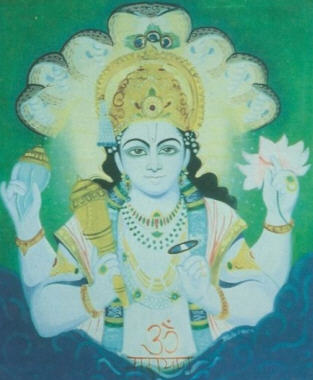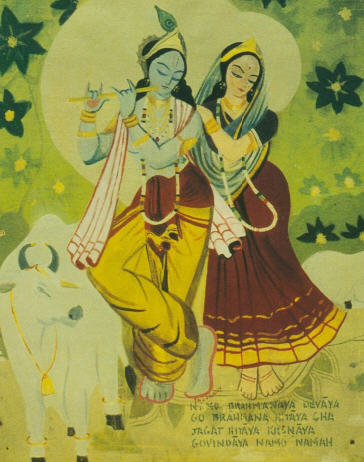
Srila Prabhupada carefully guides a young artist in painting pictures of God.
ONE DAY IN December 1966, I was cleaning the room next to Srila Prabhupada's room at 26 Second Avenue in New York City when Prabhupada called me into his room. From the trunk of books he'd brought from India he pulled out one of hisSrimad-Bhagavatam volumes and asked me to make a large painting of the picture on the cover.
The picture showed Krsna's supreme planet, surrounded by the many Vaikuntha planets in the spiritual world. Just below the Vaikuntha planets was the entire material creation. Prabhupada asked me to copy only the middle section, which showed Radha and Krsna in Goloka Vrndavana, Their supreme abode.
I was happy to do art centered on Krsna, but being born and raised in New York I didn't know what a garland was. So in my painting Radha's and Krsna's garlands looked like garden hoses. The kadamba trees in the background looked more like a light green sky with dark green stars than wish-fulfilling trees.
Nonetheless, Prabhupada seemed pleased and asked me to write a Sanskrit prayer on the lower right side of the canvas. He wrote it down for me on a piece of paper:
namo bramanya-devaya
go-brahmana-hitaya ca
jagad-dhitaya krsnaya
govindaya namo namah
The words included diacritical marks, as used by scholars for correct pronunciation. This fascinated me, and I got a small sense of how real and deeply technical the Krsna conscious tradition actually was.
Prabhupada told me the translation: "I offer my respectful obeisances to the Supreme Absolute Truth, Krsna, who is the well-wisher of the cows and the brahmanas and the living entities in general. I offer my obeisances to Govinda [Krsna], who is the pleasure reservoir for all the senses."
Three days later some Indian guests came to visit Prabhupada in his quarters and were happy to accept some sweets directly from Prabhupada's own hands. Before the guests put the prasadam in their mouths, they showed respect by touching it to their heads. Prabhupada looked at me and pointed out their reverential behavior, indicating that we, his new disciples, should follow their example of respect toward Krsna prasadam.
Then Prabhupada pointed through the glassless window of his room to the Radha-Krsna painting I had just completed, which was hanging above his altar.
"She is not painting out of concoction," he said. "She is authorized by higher authorities."
Of course, for me that higher authority was Prabhupada. His words made me feel important, not because of my own credit or quality, but because I was connected to a very important spiritual lineage.
A Dream Come True
Some days passed, and Prabhupada told me of a dream he'd had. In the dream he was in Tompkins Square Park, and thousands of people had come to hear the Hare Krsna mantra. He asked me to do a painting of his dream, which I never did.
But Prabhupada's dream soon came true. There was going to be a festival in Tompkins Square Park, and the devotees were invited to go on the huge stage to chant. Prabhupada asked me to paint a big Hare Krsna mantra sign for the occasion. I had no easel then, so on the floor of the altar room I put a large piece of oak tag (shiny white poster cardboard). At the same time, in the same room, the other devotees were preparing the Sunday Feast.
Prabhupada came to inspect our progress. The sign lay on the floor, under Prabhupada's window. To develop the painting of the letters, I was leaning over the sign, stretching my arms and entire body over the holy names to reach the other end. I suspected I was doing the wrong thing. I looked up to see Srila Prabhupada's lotus feet as he stood watching, and I told him of my reservations. He smiled and reassured me. Then he told the story of the time Krsna had a headache.
Once, Krsna asked His servant to get dust from the feet of any of His devotees. Only such dust, He said, could cure His headache. The servant went everywhere, but no one would agree.
"How can we put the dust of our feet on Krsna's head?" they all said. "We would go to hell for such an offense!"
Finally, the servant asked the gopis of Vrndavana, Krsna's most surrendered devotees. The gopis agreed to help, Prabhupada said, and he himself acted out how the gopis quickly took the dust from their feet.
"Do you not fear going to hell for such an offense?" the servant asked.
They replied, "Never mind. We shall go to hell. Just let Krsna be cured."
That was the kind of selfless devotion Prabhupada had come to teach.
"That is love," Prabhupada said. "For loving service, under the guidance of the proper authority you can take all risks."
Sri Madhava
A few days later, Prabhupada handed me a print that Hayagriva and Kirtanananda had brought back to New York from India before they'd met him. It was a Brajbasi-style rendering of Lord Visnu encircled by the ten lila-avataras ("pastime incarnations"). Prabhupada asked me to do a big oil painting, but to replicate only Lord Visnu.
On my usual 24-by-32-inch canvas I copied the original as best I could. Lord Visnu carried a conch, a club, a disc, and a lotus in His four hands. Unfortunately, I painted what looked more like a big golden ice-cream cone than a club, I made the waves of the ocean surrounding Lord Visnu look like psychedelic question marks on a turquoise background, and His hands looked unrefined, to say the least. I would go so far as to say they looked a little bit like baseball gloves.
To paint I sat on the floor of Prabhupada's altar room, the painting leaning against the wall. Often Prabhupada would come in and squat in his distinctly Indian way.
"Paint the palms of the hands pink," he suggested.
He tried to direct me, down to the finest detail. Though technically imperfect, at least nothing in the painting was speculative. Everything was bona fide, following the scriptures and the realization of a pure devotee, Srila Prabhupada. Gradually, the painting was completed, and it became known as "Lord Visnu in the Causal Ocean."
The original print from India had om superimposed over Lord Visnu's navel, but Prabhupada wanted me to render the painting differently. On a small piece of paper he wrote in Sanskrit letters the name of that particular Visnu. He asked me to copy the name under the om to make the painting more personal.
The Visnu's name was Sri Madhava, which means "husband of the goddess of fortune," but I mistakenly copied it on the painting as "SRI MADAAVA." Prabhupada pointed out my mistake. He calmly said he had written MAD-HAVA with an "H." But I couldn't accept that I had made the mistake.
"No," I said, "you wrote an A."
We went back and forth:
"A!"
"H!"
"A!"
"H!"
I eventually realized how foolish I was to argue with my spiritual master. Not only did he know Sanskrit, which I didn't, but he had perfect knowledge of everything. Naturally, Prabhupada was right. And when I came to learn a little Sanskrit, I understood that it could not have been "MADAAVA."
Several devotees were in Prabhupada's room when I presented him the finished work.
"Now, who cannot look at that and say it is not God!" Prabhupada announced, and all of the devotees cheered.
"It is beautiful," I thought. "I don't know if I can ever do one that good again, but I sure will try."
The unfortunate fact, however, was that technically the painting was terrible, but with Prabhupada's encouraging words I was able to continue trying to render him service. Had I not received so much encouragement, I might have stopped. But Prabhupada was confident that Krsna would carry what his disciples lacked.
Prabhupada gave me a list of the twenty-four main Visnu incarnations, along with Their particular arrangements of hand symbols.
Radha-Krsna and the Cows

In late December, Prabhupada was planning to make a recording with his disciples. It would be his first Hare Krsna record album. He invited me to go with him.
"I can't," I said, "I have to see a friend in the hospital."
Prabhupada showed no resentment, even though he had wanted all his disciples to accompany him. He was kind and understanding. He handed me a gift: a beautiful, heavenly-looking three-by-five-inch print of Lord Krsna and His eternal consort, Srimati Radharani. Radha and Krsna appeared to be young children and at the same time the primeval personalities.
The photo seemed to glow. Radharani's face looked simple and sweet, but with an expression of wisdom and compassion. She seemed to have an otherworldly bliss. Her opulent Vraja gopi sari, cool pink and brown, complemented Krsna's dhoti, sash, and cadar (shawl). And Her bright golden complexion complemented His blue pearl-like hue.
Prabhupada soon went to San Francisco. While he was gone I made a large painting from the print about three feet by four. The devotees hung it on the wall over Prabhupada's vyasasana [the seat of the guru]. When Prabhupada returned to New York, he saw the painting hanging there, and just before sitting down on his vyasasana he offered his obeisances to the painting by bending over and putting his head on the side of his seat.
Yadurani Devi Dasi was the first woman to join Srila Prabhupada's fledgling Hare Krsna movement in New York in 1966. She now travels to teach others about Krsna.
